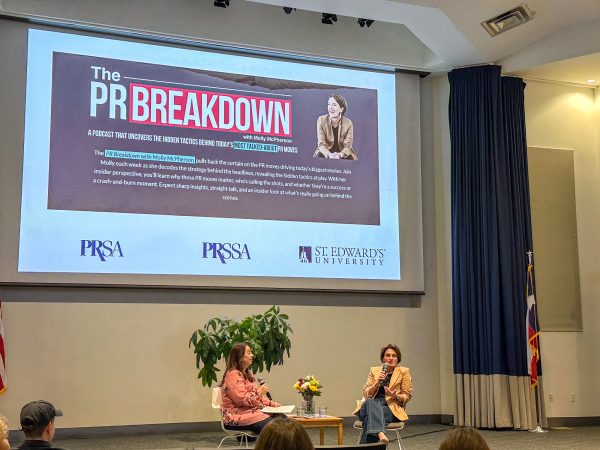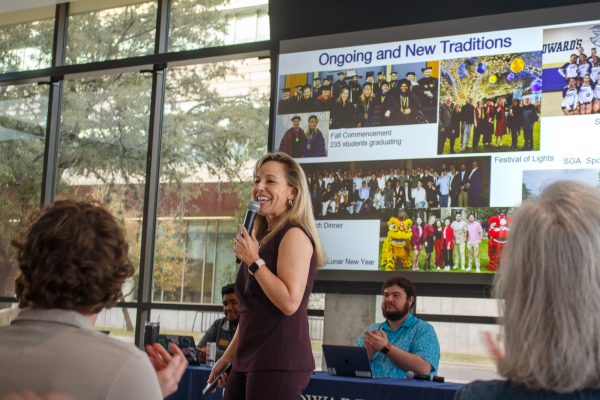Tenured track safe for now
While there is a nationwide trend of universities moving away from tenured track professor positions, St. Edward’s University is not a part of it.
Sr. Donna Jurick, university provost, said that the tenured track will remain in place at the university for the foreseeable future.
The tenured track for professors has been disappearing from campuses, according to a 2009 article from the online publication “Inside Higher Ed,” entitled “The Disappearing Tenure-Track Job.”
Since the faculty population is proportional to the student population, Jurick said that tenured positions at St. Edward’s will remain open, so long as enrollment remains healthy.
“Over the past two years, the undergraduate population has almost doubled, and the faculty population has grown in proportion to the student population,” Jurick said.
Jurick added that the number of faculty has increased with the amount of students.
“In 1998, we had 132 contracted faculty who were not adjuncts,” she said. “In Fall 2009, we had 226 faculty; it includes tenured professors.”
One possible reason for this trend is St. Edward’s steady enrollment.
To suspend the tenure-track position, current faculty members would have to hold a discussion and vote.
“[The faculty] would have to have some recommendation from the administration, and it would have to have the approval of the Board of Trustees. I don’t foresee that at the moment,” Jurick said.
Jurick said that, in a sense, tenure is already suspended at St. Edward’s and has been since 1998, when the faculty decided against an “up-or-out” system.
“Normally when you use the word ‘tenure,’ that’s the connotation—that if you do not get tenure, then you must leave the university,” Brenda Vallance, dean of the School of Behavioral and Social Sciences, said.
The absence of an “up-or-out” tenure system differentiates St. Edward’s from most other institutions.
A large number of universities require professors to apply for tenure after a certain period of time and mandate that they must leave should their application be rejected. St. Edward’s participates in neither of these practices.
Furthermore, Vallance suggested that increasing numbers of adjuncts is not necessarily a negative occurrence.
“There are times when you want adjuncts, because they bring specialized knowledge that you don’t have among your full-time faculty,” Vallance said. “Or it’s so specialized that you would not hire a faculty member in that area.”
The School of Business has an entrepreneurship program that employs several adjunct professors. The Forensic Science program on campus follows the same practice. These fields are so specialized that St. Edward’s hires professionals in those fields as adjuncts.
Vallance also said that tenure has two sides to it. In the first place, tenure was established to protect the academic freedom of professors. However, she also recalled an instance at another university where a faculty member thoroughly abused his tenured status.
Another practice differentiating St. Edward’s from other universities is the review process.
“Every faculty member is reviewed every year,” Vallance said. “Quite often, if you have a tenure system, you don’t review those people. Even tenured professors [at St. Edward’s] have a yearly review.”
Tenured professors at St. Edward’s—like all other faculty—do self-evaluations as well, where they are encouraged to set their own goals and assess their performance. Of all of the systems that Vallance has experienced, she said that she believed the one at St. Edward’s is the best.
Professor Henry Altmiller has taught at St. Edward’s for 37 years and hasn’t applied for tenure once. He said that suspension of the tenure-track at other universities would, because of the “up-or-out” system, have serious effects on educational quality and continuity. However, he thinks the case would be different at St. Edward’s.
“To grant or not to grant tenure at St. Ed’s would not have any adverse effects, I think,” Altmiller said.
Due to the growth at St. Edward’s over the past years, the university is now competing against different institutions, including Southwestern University, Trinity University and Rice University. As St. Edward’s moves into a new bracket of educational institutions—especially those that generate published academic texts—the tenure system may meet reform.
“My impression is that St. Edward’s is still in the process of hammering out tenure,” Assistant Professor Peter Austin said. “It is trying to figure out the best road. It’s also figuring out where publishing comes into the equation.”
Austin said that he thinks St. Edward’s will find the best road.
“St. Edward’s takes care of its people and allows them to flourish,” he said.
As St. Edward’s steps into a new realm of academia, enrollment remains steady and the faculty body is strong. Administration hopes to retain the personal touch that has been one of the university’s trademark qualities.
“I think I’d put our faculty up against anybody that has [up-or-out] tenure,” Jurick said. “I think we’re as rigorous as they are. I think we do it more compassionately.”






